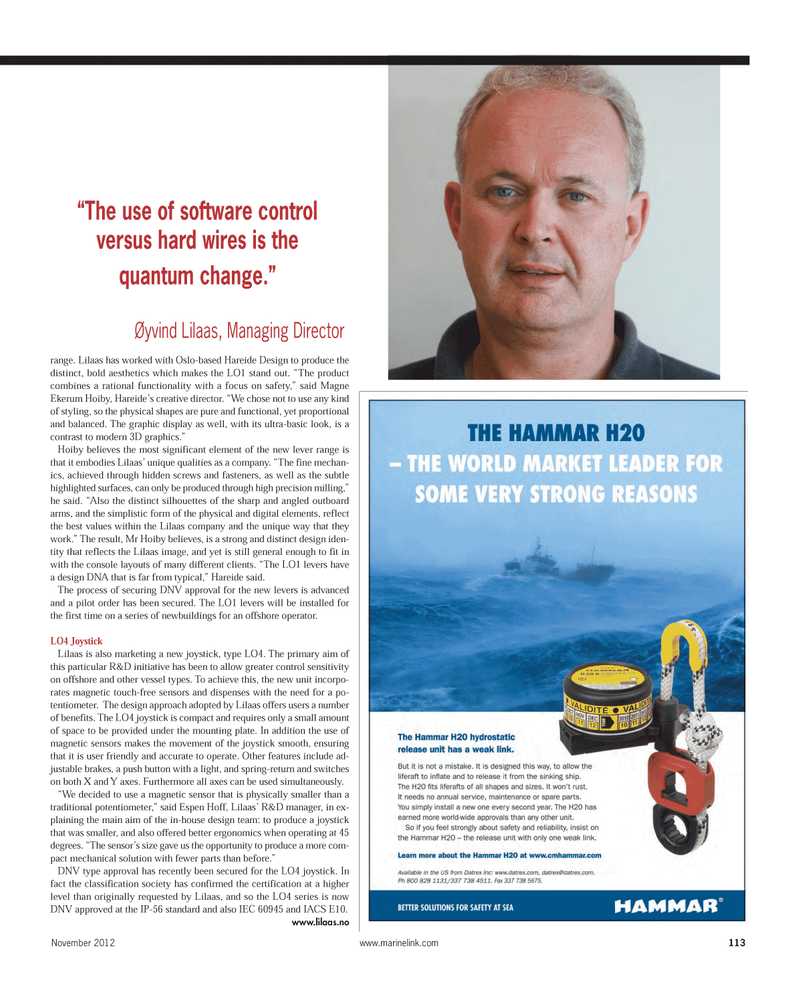
Page 113: of Maritime Reporter Magazine (November 2012)
Workboat Annual
Read this page in Pdf, Flash or Html5 edition of November 2012 Maritime Reporter Magazine
range. Lilaas has worked with Oslo-based Hareide Design to produce the distinct, bold aesthetics which makes the LO1 stand out. ?The product combines a rational functionality with a focus on safety,? said Magne Ekerum Hoiby, Hareide?s creative director. ?We chose not to use any kind of styling, so the physical shapes are pure and functional, yet proportional and balanced. The graphic display as well, with its ultra-basic look, is a contrast to modern 3D graphics.? Hoiby believes the most significant element of the new lever range is that it embodies Lilaas? unique qualities as a company. ?The fine mechan- ics, achieved through hidden screws and fasteners, as well as the subtle highlighted surfaces, can only be produced through high precision milling,? he said. ?Also the distinct silhouettes of the sharp and angled outboard arms, and the simplistic form of the physical and digital elements, reflect the best values within the Lilaas company and the unique way that they work.? The result, Mr Hoiby believes, is a strong and distinct design iden- tity that reflects the Lilaas image, and yet is still general enough to fit in with the console layouts of many different clients. ?The LO1 levers have a design DNA that is far from typical,? Hareide said. The process of securing DNV approval for the new levers is advanced and a pilot order has been secured. The LO1 levers will be installed for the first time on a series of newbuildings for an offshore operator. LO4 Joystick Lilaas is also marketing a new joystick, type LO4. The primary aim of this particular R&D initiative has been to allow greater control sensitivity on offshore and other vessel types. To achieve this, the new unit incorpo- rates magnetic touch-free sensors and dispenses with the need for a po-tentiometer. The design approach adopted by Lilaas offers users a number of benefits. The LO4 joystick is compact and requires only a small amount of space to be provided under the mounting plate. In addition the use of magnetic sensors makes the movement of the joystick smooth, ensuring that it is user friendly and accurate to operate. Other features include ad-justable brakes, a push button with a light, and spring-return and switches on both X and Y axes. Furthermore all axes can be used simultaneously. ?We decided to use a magnetic sensor that is physically smaller than a traditional potentiometer,? said Espen Hoff, Lilaas? R&D manager, in ex- plaining the main aim of the in-house design team: to produce a joystick that was smaller, and also offered better ergonomics when operating at 45 degrees. ?The sensor?s size gave us the opportunity to produce a more com- pact mechanical solution with fewer parts than before.? DNV type approval has recently been secured for the LO4 joystick. In fact the classification society has confirmed the certification at a higher level than originally requested by Lilaas, and so the LO4 series is now DNV approved at the IP-56 standard and also IEC 60945 and IACS E10. www.lilaas.no November 2012www.marinelink.com 113?The use of software control versus hard wires is the quantum change.?Øyvind Lilaas, Managing Director MR#11 (106-113):MR Template 11/6/2012 10:56 AM Page 113

 112
112

 114
114
